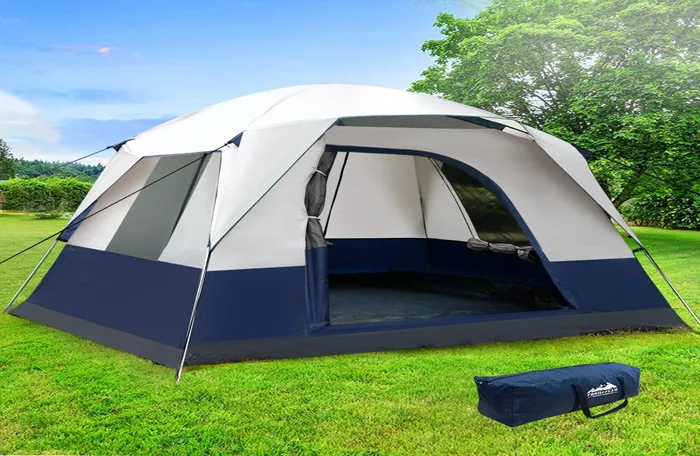A camping tent is a portable shelter designed for outdoor use. It provides protection from weather elements like rain, wind, and sun. Tents are essential gear for campers, hikers, and outdoor enthusiasts. They come in various shapes, sizes, and materials to suit different needs.
The basic tent consists of a fabric shell supported by poles and secured to the ground with stakes. Modern tents use lightweight materials for easy carrying. They offer a private space to sleep and store gear in nature.
History of Tents
Early Origins
Tents date back thousands of years. Nomadic tribes used animal skins and wooden poles to create movable homes. Ancient armies employed tents as field headquarters. These early shelters were heavy and required animals to transport.
Modern Developments
The 20th century brought major improvements. Nylon fabric replaced canvas in the 1950s, making tents lighter. Aluminum poles appeared in the 1960s, offering strength without weight. Recent advances include waterproof coatings and breathable fabrics.
Today’s tents combine durability with portability. High-tech materials withstand harsh conditions while packing small. Designs have evolved for specific activities like backpacking or family camping.
Tent Components
Fabric
Most tents use nylon or polyester fabric. These synthetic materials resist water and dry quickly. Rainfly covers add extra waterproofing. Mesh panels provide ventilation while keeping insects out.
Poles
Tent poles create the structure. Aluminum is common for its strength and lightness. Fiberglass poles are cheaper but heavier. Some ultralight tents use carbon fiber poles.
Stakes and Guylines
Stakes anchor the tent to the ground. Guylines add stability in wind. Quality stakes won’t bend easily. Reflective lines improve visibility at night.
Zippers and Doors
Durable zippers allow easy entry. Double doors prevent disturbance. Some tents feature vestibules for gear storage outside the sleeping area.
Types of Tents
Backpacking Tents
These prioritize weight and pack size. They sleep 1-3 people with minimal space. Light materials and simple setups suit long-distance hikers.
Family Camping Tents
Larger tents accommodate groups. They have multiple rooms and high ceilings. Setup takes more time but offers comfort for base camping.
Four-Season Tents
Designed for winter use, these withstand snow and strong winds. They have less ventilation but more structural support. The fabric is heavier for insulation.
Pop-Up Tents
These tents spring open automatically. Ideal for festivals or quick setups. They sacrifice durability for convenience.
Hammock Tents
A hybrid between hammock and tent. Suspended between trees with bug protection. Requires no flat ground but needs anchor points.
Tent Features
Waterproofing
Measured in hydrostatic head (mm). Higher numbers mean better rain resistance. Seam tape prevents leaks at stitching points.
Ventilation
Mesh panels reduce condensation. Adjustable vents control airflow. Proper ventilation prevents stuffiness and moisture buildup.
Storage
Pockets keep small items organized. Gear lofts utilize overhead space. Vestibules protect packs from weather.
Setup Systems
Color-coded poles simplify assembly. Clip attachments speed up pitching. Freestanding designs don’t require stakes for basic setup.
Choosing the Right Tent
Consider Your Needs
Think about how many people will use it. Decide between car camping or backpacking. Consider the seasons you’ll camp in.
Weight Matters
Backpackers should aim for under 3 pounds per person. Car campers can prioritize space over weight. Remember to include stakes and poles in total weight.
Weather Protection
Check the waterproof rating. Look for full-coverage rainflies in wet climates. Choose four-season tents for winter camping.
Setup Ease
Practice pitching at home first. Freestanding tents work on any surface. Non-freestanding models require proper staking.
Tent Care and Maintenance
Cleaning
Wipe dirt with a damp cloth. Use mild soap for stubborn stains. Never machine wash as it damages coatings.
Drying
Always dry completely before storage. Moisture causes mold and mildew. Hang in sunlight to eliminate odors.
Storage
Keep loosely packed in a cool, dry place. Avoid compression for long periods. Store poles separately to prevent bending.
Repairs
Patch small holes with repair tape. Replace broken poles sections. Reapply waterproofing as needed.
Tent Safety
Location Selection
Avoid low spots that collect water. Look for natural wind protection. Clear the area of sharp objects.
Weather Awareness
Check forecasts before camping. Know when to evacuate in storms. Reinforce guylines in high winds.
Fire Safety
Keep flames away from tent fabric. Use battery-powered lights inside. Never cook in your tent.
Wildlife Precautions
Store food away from sleeping areas. Use bear-proof containers when needed. Keep tent zipped to prevent insect entry.
Environmental Considerations
Leave No Trace
Choose established campsites when possible. Avoid damaging vegetation. Pack out all waste.
Sustainable Materials
Some brands use recycled fabrics. Look for eco-friendly waterproof coatings. Durable tents reduce replacement frequency.
Low-Impact Camping
Use existing fire rings. Minimize ground disturbance. Camp at least 200 feet from water sources.
Future Trends
Smart Tents
Integrated lighting and charging ports. Solar-powered ventilation systems. Weather monitoring sensors.
Advanced Materials
Self-repairing fabrics. Improved biodegradable options. Lighter yet stronger composites.
Innovative Designs
Modular components for customization. Quicker setup mechanisms. Improved space efficiency.
Conclusion
A good tent transforms outdoor experiences. It provides shelter and security in nature. Understanding tent features helps choose the right one. Proper care extends a tent’s lifespan. Whether backpacking or family camping, the right tent makes adventures more enjoyable. Always prioritize quality and suitability for your needs. Happy camping!
Related topics:
Best Canopy Tent for Camping: A Detailed Guide
Best Camping Dome Tent: A Detailed Guide
Best Cabin Tent: A Complete Guide for Outdoor Enthusiasts

